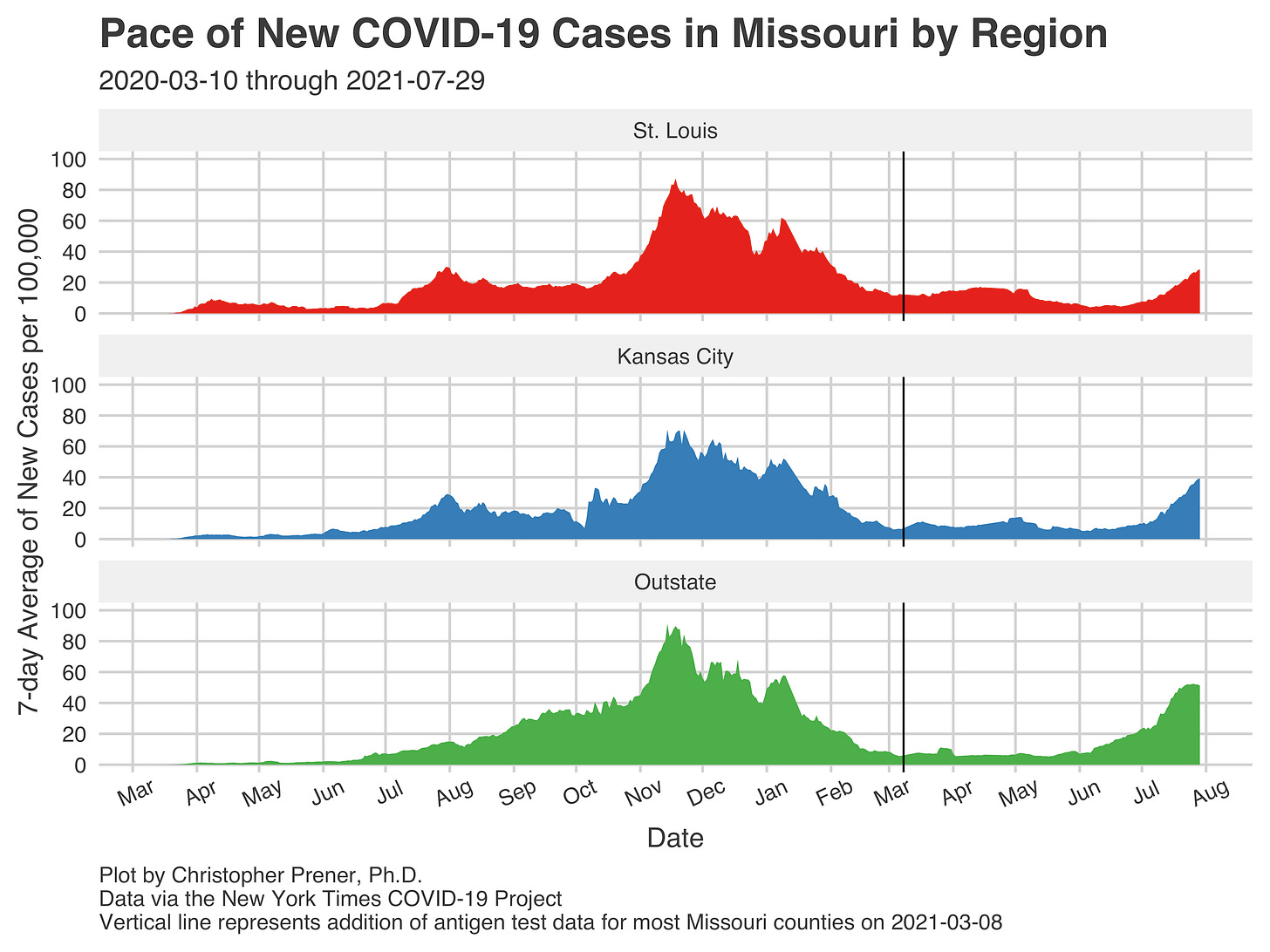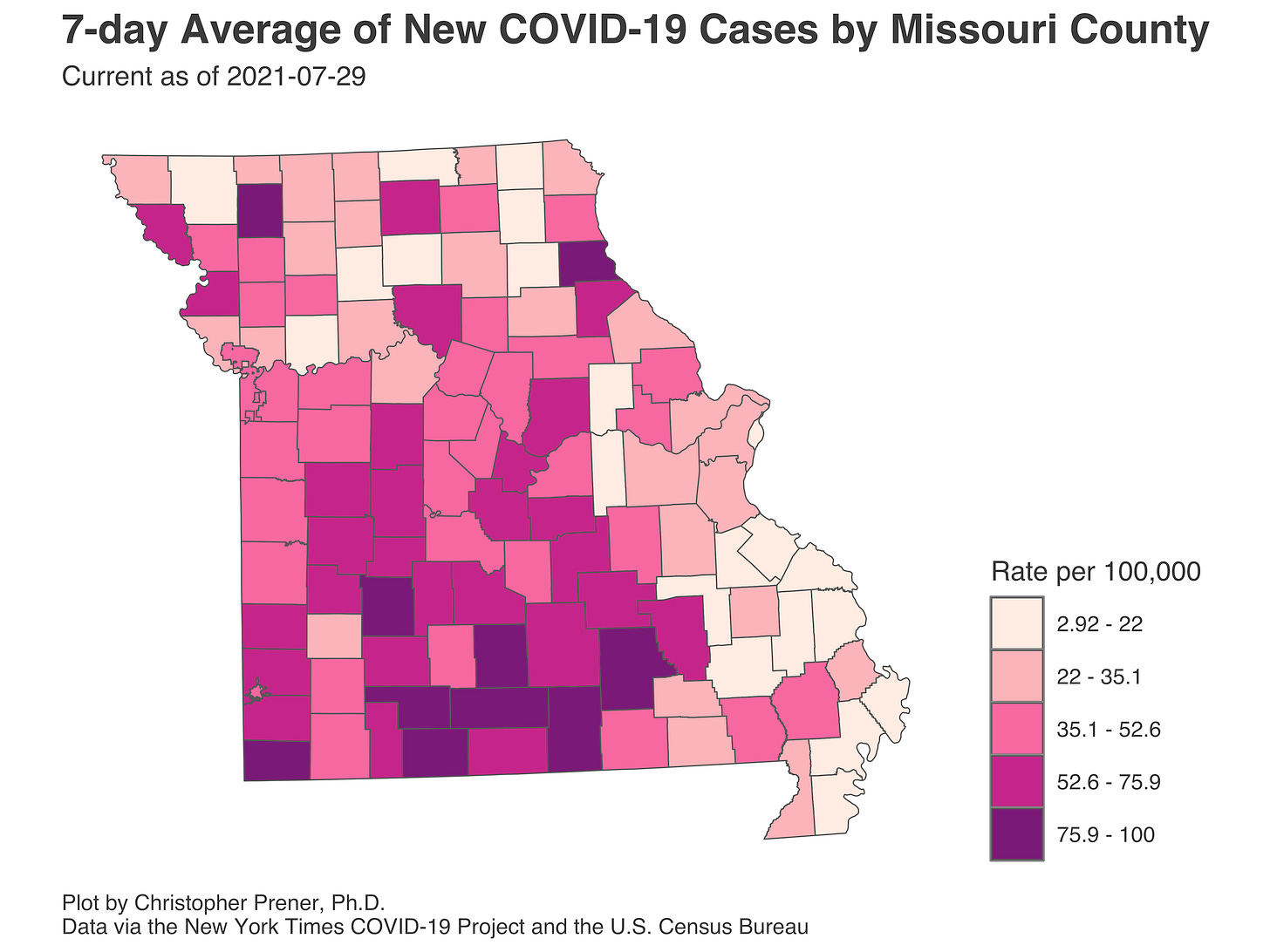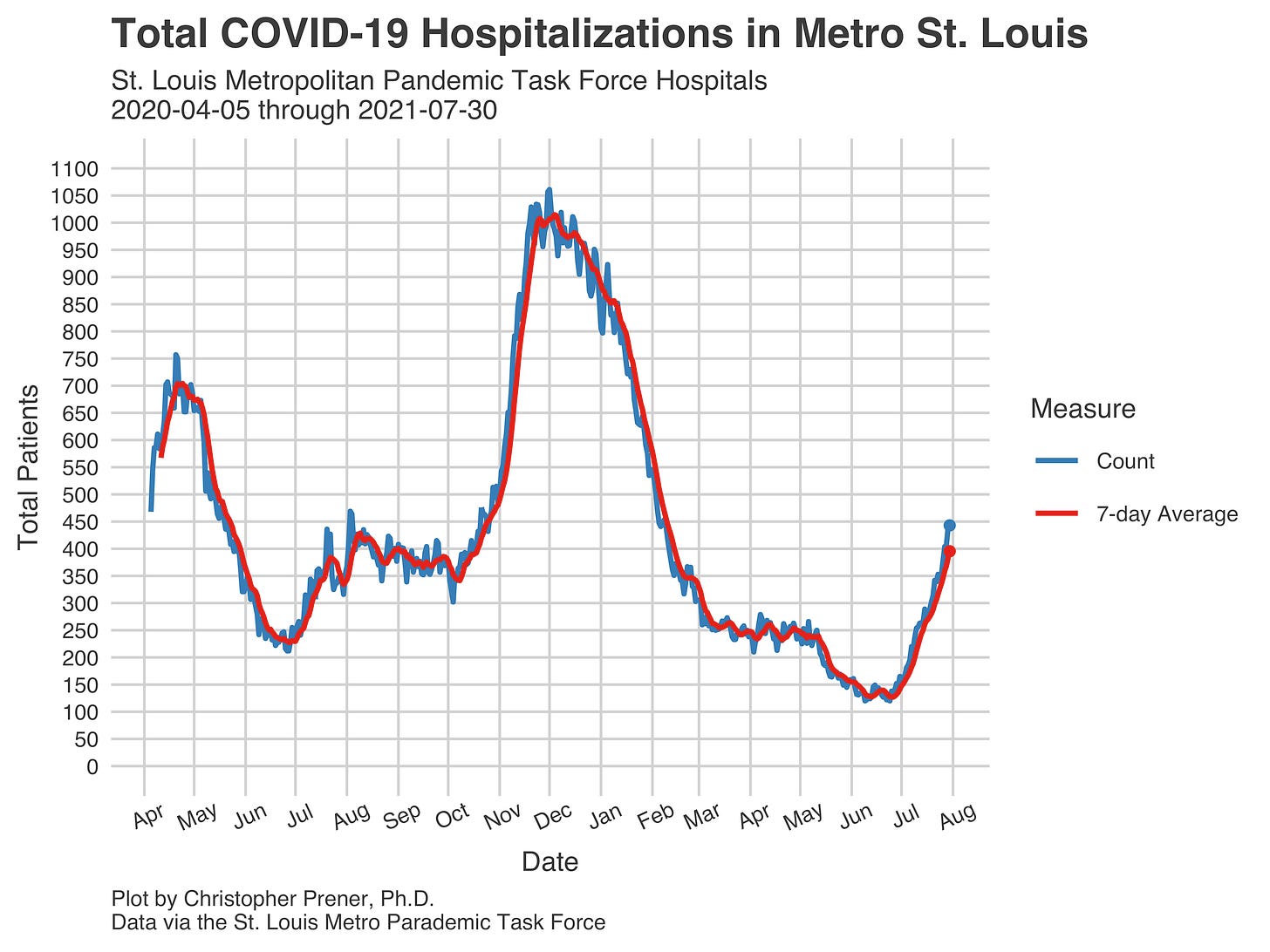Missouri’s standing among states has dropped just a bit - we are not sixth nationally for new cases. None of our counties are in the top twenty for new cases nationally (among those with 10,000 residents or more). This sounds good, right? Unfortunately, this is more of a statement about how high case rates have become in Louisiana in particular, but also in Florida, Mississippi, and Alabama. Rates in Missouri have ebbed rather than dropped, and the state reported 4,217 new cases today that are not reflected in the data presented below. The situation in Missouri remains quite precarious, even if it is rapidly worsening elsewhere. - Chris
COVID-19 by the Numbers
Total cases in MO: 689,392 (+17,452 from last Friday)
7-day average of new cases per day in MO: 2,493.14 (+245 from last Friday)
Counties with the highest per capita rates (per 100,000) of new cases per day this past week:
Taney (100.25 per 100,000), Shannon (98.75), Gentry (94.31), Howell (93.33), McDonald (92), Marion (86.69), Douglas (82.25), and Christian (81.71)
Total deaths in MO: 10,283 (+104 from last Friday)
7-day average of new deaths per day in MO: 14.86 (+2.86 from last Friday)
Percent of all Missourians initiating vaccination: at least 43% (+3% points from two weeks ago)
Percent of all Missourians completing vaccination: at least 37% (+2% points from two weeks ago)
Case and mortality numbers are current as of Thursday, July 29th. Vaccination numbers are current as of Friday, July 30th. Additional statistics, maps, and plots are available on my COVID-19 tracking site.
Illness Trends in the Past Week
Much of our attention has been on “outstate” Missouri over the past two months. Over the past week, we have seen the rates in that large swath of Missouri stabilize significantly and even drop slightly. I am not comfortable saying that we are putting the worst part of this wave outstate behind us, but it is a significant change worth watching. At the same time, rates in Kansas City continue to grow steeply and are ticking upward at a slower pace in St. Louis.
While cases may have ebbed outstate, the general story on high rates remains relatively the same. Southwest Missouri continues to anchor the “Ozark” cluster, which includes significant portions of Mid-Missouri, Arkansas, Northeast Oklahoma, and a growing number of counties in Southeast Kansas. Northeast Missouri and counties near St. Joseph also have elevated rates.
I am not ready to close the door on outstate Missouri because there are two areas where we have yet to see any significant change in new cases. You can see both on the map above - the Bootheel counties along the Mississippi and the counties around Cape Girardeau. The exception in this part of Missouri is two counties - Butler (where new cases have plateaued) and Stoddard, which has the highest rate in the region.
What we have seen elsewhere in Missouri over the past two months is that one or two counties can seed a wider regional outbreak. Given the spread of new cases elsewhere in Missouri, I am skeptical of the idea that Southeast Missouri can avoid a similar spike in cases.
I am also concerned about the potential for growth in the Ozark Mountains, especially in Howell, Shannon, Ozark, and Reynold counties. Despite improvements in Oregon and Carter counties, they are by no means out of the woods either.
Most counties in Southwest Missouri up through Mid-Missouri are following the general trend that the key regional metros are - ebbing but without signs of significant drops. Jefferson City is a special case because it relies heavily on Cole County’s rate of new cases, which is subject to swings due to data reporting. However, Columbia, Joplin, Springfield, and St. Joseph are holding steady on their high rates of new cases.
St. Louis still seems to be lagging behind Kansas City in terms of new cases by perhaps a week or two. I am particularly interested in whether the large number of new cases reflected in my data tomorrow show significant growth in the Kansas City area. I am also wondering if we will start to see a bump in new cases around Cape Girardeau. The reason why is that hospitalizations are starting to climb there. We have seen hospitalizations precede new cases in several cases since mid-May, and that may signal that Cape Girardeau’s low rate of new cases is coming to an end.
I also want to watch the hospitalization rates in three other metros - Jefferson City, Joplin, and Springfield - closely. Springfield’s hospitalization rate has already eclipsed the number of in-patients from the fall surge. With renewed growth in new cases in McDonald County, Northeast Oklahoma, and Southeast Kansas, Joplin’s rate may not remain plateaued.
Here in St. Louis, more recent hospitalization data than what we get from the federal government shows steadily rising numbers of in-patients over the end of July. We have hit a seven-day average of 400 patients, and our latest number of confirmed and suspected COVID-19 patients has reached nearly 450 for the first time since early February.
Vaccination Trends in the Past Week
Vaccinations continue to tick upward in Southwest Missouri as well as the Ozarks and Mid-Missouri. This is good news and seems to indicate that high rates of community transmission do spur people to get vaccinated. The downside, of course, is that it takes weeks to reach a “fully immunized” state. That said, increasing vaccination will bode well for the fall and winter here in Missouri.
If you like what you see here and don’t already, please subscribe!










